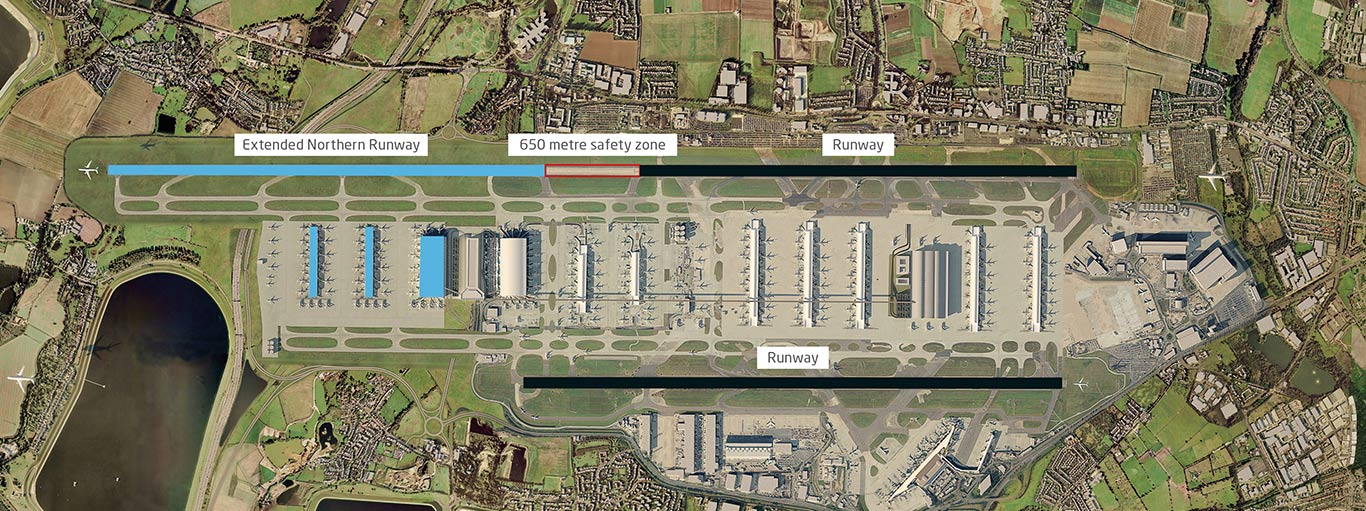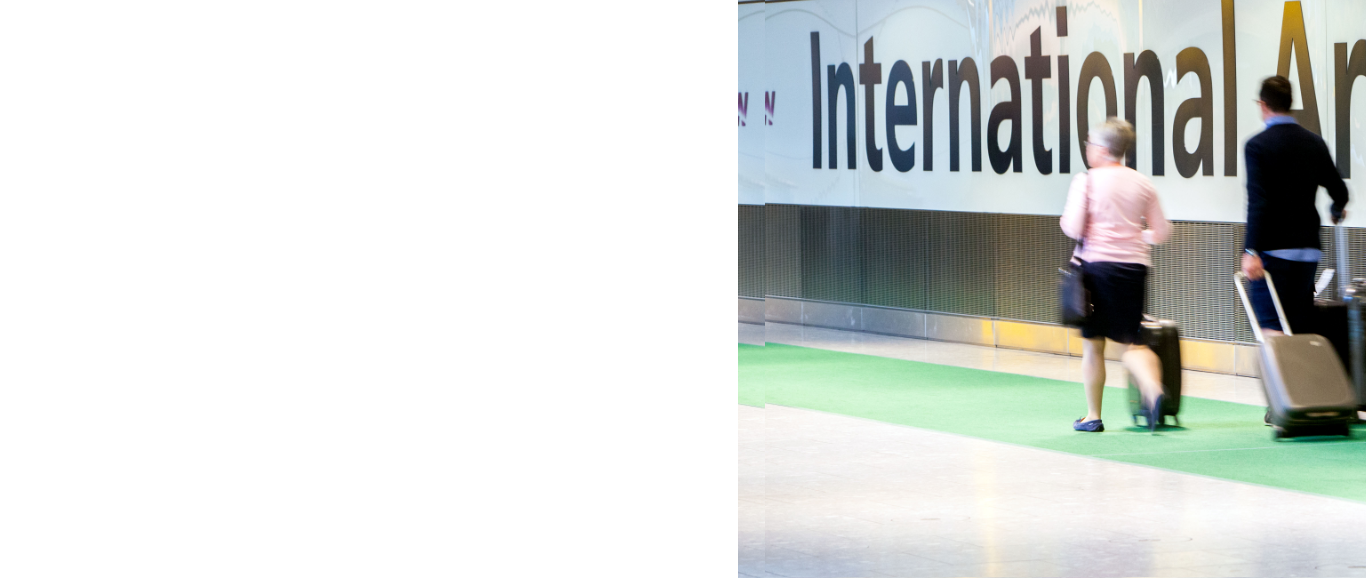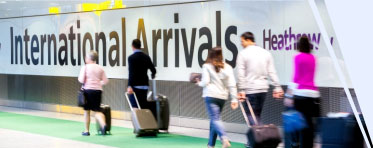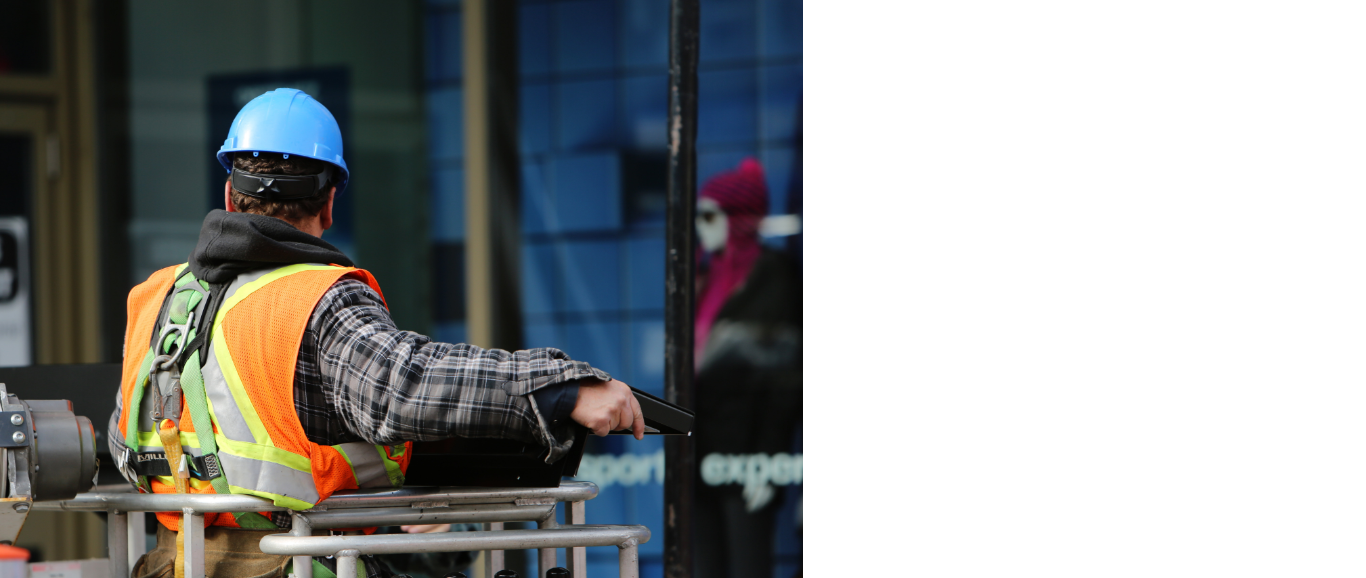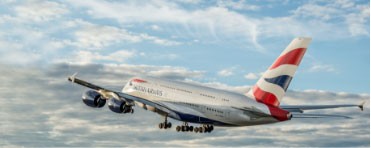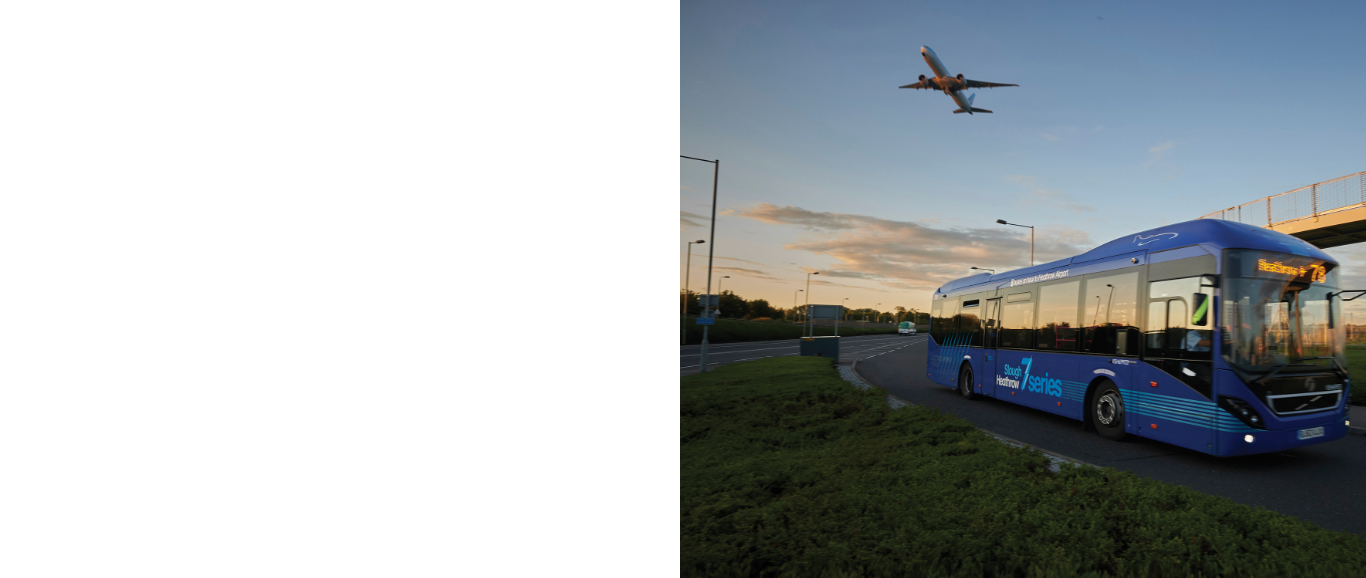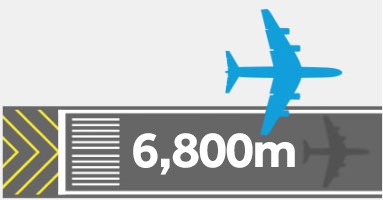
What is the Extended Northern Runway?
We propose to extend Heathrow’s existing northern runway to a total length of around 6,650 metres.
-
By dividing the existing runway in two with a 650m safety area, we create an extended single runway with two separate runway strips, allowing aircraft to simultaneously land on one and take off on the other. This provides the same much needed new capacity as a 3rd runway.
The runway extension would mean re-routing a short section of the M25 which, unlike Heathrow Airport Ltd's scheme is well to the south of the M4 junction, providing an opportunity to widen this key artery and ease
-
traffic flows. All construction would be carried out with minimal disruption and the motorway is not expected to close at any time.
The concept is the brainchild of Jock Lowe, former head of operations at British Airways and the longest serving Concorde pilot. It is supported by some of the world’s leading engineering firms and aviation consultancies, including Aecom, Gardiner + Theobald and Helios.
Extending the northern runway is:
Cheaper
Minimising the cost of airport expansion and protecting consumers is key.
-
Heathrow Hub has a significantly lower capital cost than Heathrow Airport Ltd’s third runway. A first phase, costing £4.7bn (at 2014 prices), provides capacity for 70,000 additional aircraft movements.
We estimate that the total cost of our scheme comprising airport expansion and road infrastructure, including limited land and property acquisition and compensation, would be £9.7bn (at 2014 prices). Our proposals would be phased, allowing capacity to be developed as demand increases, but only if environmental and noise targets are met.
Our low cost means that Heathrow’s air passenger fees would be unchanged, and potentially reduced.
-
By contrast, Heathrow Airport Ltd has so far declined to publish any detailed cost estimates but our analysis shows that its first phase alone would cost over £24bn (at 2014 prices) with the whole scheme cost unknown but likely to exceed £35bn (at 2014 prices). The CAA has said it is now concerned about these costs which have, “increased significantly and are now very material.” It has refused to approve a tripling of the pre-planning budget, to £2.9bn, and continues to consult on Heathrow Airport Ltd’s costs and efficiency. Furthermore, IAG, by far Heathrow's biggest user, has warned that passenger charges could double as a result of the 3rd runway.
Greener
Phased construction to allow emissions targets to be met
-
A key advantage of Heathrow Hub’s extended northern runway proposal is that construction can be phased, giving the government the ability to assess compliance with air quality and noise targets before releasing any new capacity.
At a time when the government focus is on net zero carbon emissions by 2050, Heathrow Hub’s proposal has been structured to ensure environmental standards are met, not compromised, by its expansion plans.
-
Unlike Heathrow’s proposal, which relies on 50% more aircraft within two years of opening its 3rd runway, our low-cost scheme does not depend on any additional aircraft movements. Instead, it will allow, in the first instance, the same number of aircraft to operate far more efficiently and quietly as:
- There will be less taxiing and holding, both on the ground and in the air.
- Aircraft will burn less fuel and therefore reduce emissions.
-
- Deep landings in early mornings and deep take-offs in late evenings will reduce noise impacts
Only once the government is satisfied that environmental and noise targets have been met within the existing 480,000 ATM cap will further additional capacity be considered for release.
Safe
This is a safe solution for expansion: the safety zone between the runways is 650m, over twice the length required by international regulations.
-
We have completed a thorough independent safety review with international consultants and aviation experts and the CAA has conducted its own preliminary safety review.
Our independent review concludes that our proposal is safe and efficient and complies with all relevant regulatory requirements. It has been deemed viable by the Airports Commission.
Quicker and Simpler
Our extended runway can be completed before the 3rd runway. Less land is required minimising the impact on the local community. Generous compensation to those affected.
-
Even at this late stage in the process, our extended runway could be operational before Heathrow Airport Ltd's 3rd runway and within five years. In contrast, HAL has had over nine years to develop a credible, viable and affordable scheme, yet their 2019 consultation showed that its proposals remain at an early conceptual stage. It is very hard to see how this can ever be delivered, given it has already been subject to delays and completion is impossible by the Government’s assumed opening date of 2026.
Our scheme will result in much less community disruption and has been designed to minimise the impact on local communities; 242 homes, that currently sit at the end of one of the existing runways
-
and next to the M25 will be lost as opposed to the 783 houses that would be demolished if the 3rd runway is built. Our lower cost proposal allows us to offer far more generous compensation to those affected.
Extending the runway does not require any of the major infrastructure that surrounds Heathrow to be moved. As HAL’s statutory consultation made clear, their proposal will not only take an unprecedented amount of land from London’s precious green belt, but requires land far beyond the red line boundary in the designated Airports National Policy Statement (ANPS). Heathrow Airport Ltd's scheme is impossible to deliver without moving significant infrastructure such as the Lakeside Energy from Waste plant, BA’s Waterside HQ, the Home Office
-
Immigration Removal Centres and Network Rail’s Colnbrook freight branch – as well as a large number of Heathrow’s hotels, logistics centres and offices.
Under our proposal, the M25 would continue to operate as normal, as construction of our proposed 16 lane section will take place offline. The switch over can be done with some overnight lane closures.
Our quicker and simpler scheme is far less land hungry, much less damaging to the environment and local communities and results in lower cost and programme risk.
Road and Rail
Better connectivity, less congestion.
-
Our proposal will not only enhance air connectivity to UK regional airports and the world’s emerging markets, but also includes the potential to better connect Heathrow to the national road and rail network.
The lower capital cost will mean Heathrow Airport Ltd could afford to support investment in surface access, including direct rail links to the large and unserved catchment to the south and west as well as to Clapham Junction, with connections to Sussex and Waterloo, with connections to Kent via Waterloo East.
-
Better connectivity, less congestion.
The UK’s road networks will only become more congested over the next 30 years and as a result, less reliable with longer journey times for passenger and employees. Our surface access proposals connect Heathrow with all major rail and road networks.
For the first time, there would be direct rail access to the airport from the west and south, transforming accessibility and providing an attractive alternative to the car.
Quieter
Heathrow Hub would avoid bringing any new communities into the overall noise footprint. Phased construction to allow for noise targets to be met.
-
By extending the existing runway we maintain current flight paths and no new communities are brought into the airport’s overall noise footprint. For those communities within the existing footprint, we can increase respite by using different parallel approaches on rotation. We are also committed to developing innovative noise reduction tactics.
The additional runway capacity which we propose, allowing as many as 260,000 additional slots if environmental limits can be met over time, would
-
give the opportunity to limit the most disruptive night quota flights that arrive between 4.30am and 6am. Arriving aircraft could land 2.5 miles further west on the new runway extension, moving the entire noise footprint and reducing sleep disturbance for many West London residents.
Heathrow Hub endorsed the Airports Commission’s recommendation for an Independent Noise Regulator to take a holistic view of aircraft noise, with the ability to put in place, and enforce, new procedures.
-
Absolute aircraft noise is being reduced as modern aircraft are able to meet even more restrictive noise criteria. There are also a number of aircraft and air traffic control operating techniques we can employ that make it possible to change the frequency of concentrated noise, and to provide respite in noise frequency by changing routes.
